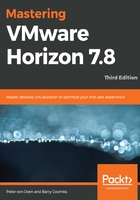
vDGA
While vSGA works on a shared basis, vDGA allows for an individual VM to have its own dedicated access to a physical GPU card installed in the ESXi host server. This allows the virtual desktop machine to have a higher level of graphics performance, making it perfect for such use cases as CAD/CAM applications, as it supports DirectX (9, 10, and 11), OpenGL 4.4, and NVIDIA CUDA.
The following diagram shows the architecture for vDGA:

The vDGA solution makes use of a feature called VMDirectPath I/O pass-through, sometimes referred to as PCI pass-through, which allows the virtual desktop machine to pass through the hypervisor layer and directly access the hardware in the host server. In this case, the hardware in question is the NVIDIA GPU cards.
As a VDI Desktop is mapped directly to a GPU on a one-to-one basis, you cannot use vSphere features such as HA, DRS, or vMotion.